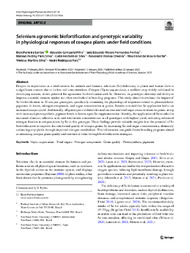Embrapa Meio-Norte
 Publicações
Publicações
Selenium agronomic biofortification and genotypic variability in physiological responses of cowpea plants under field conditions.
Autoria: SANTOS, E. F.; COMPARSI FILHO, E.; FONTES, L. E. M. F.; SILVA, M. A. P.; SILVA, G. N.; OLIVEIRA, A. A.; ROCHA, M. de M.; SILVA, V. M.; REIS, A. R.
Resumo: Despite its importance as a vital nutrient for animals and humans, selenium (Se) deficiency in plants and human diets is a significant concern due to its low soil concentrations. Cowpea (Vigna unguiculata), a resilient crop widely cultivated in developing nations, shows potential for agronomic biofortification with Se. However, its genotypic diversity and ability to improve essential element uptake are often overlooked in breeding programs. This study aimed to evaluate the impact of Se biofortification in 20 cowpea genotypes, specifically examining the physiological responses related to photosynthetic pigments in leaves, nitrogen compounds, and sugar concentration in grains. Results revealed that Se application led to an increased cowpea yield. Additionally, all genotypes exhibited elevated sucrose and total sugar concentrations in grains, along with increased photosynthetic pigment levels in leaves upon Se supplementation. Notably, the application of Se resulted in increased allantoin, allantoic acid, and total ureide concentrations in all genotypes with highest yield, indicating enhanced nitrogen fixation in cowpea plants by Se in this genotype.
Ano de publicação: 2025
Tipo de publicação: Artigo de periódico
Unidade: Embrapa Meio-Norte
Palavras-chave: Compostos de nitrogênio, Pigmentos fotossintéticos, Qualidade do grão, Vigna Unguiculata
